"Art and Love in Renaissance Italy" @ The Kimbell Art Museum, Forth Worth
Paris Bordon, Venus, Mars, and Cupid Crowned by Victory, c. 1550. Oil on canvas, 44 x 683⁄4 in. Kunsthistorisches Museum, Gemäldegalerie, Vienna
FORT WORTH, TX.- The Kimbell Art Museum presents Art and Love in Renaissance Italy, a fascinating exploration of art objects made to celebrate milestones in the lives of men and women in Renaissance Italy—betrothal, marriage, and the birth of a child. It will be on view from March 15 to June 14, 2009. Jointly organized by The Metropolitan Museum of Art, New York, and the Kimbell (its exclusive venues), this exhibition is curated by Andrea Bayer, a curator in the department of European paintings at The Metropolitan Museum of Art, and Nancy E. Edwards, curator of European art and head of academic services at the Kimbell Art Museum.
Art and Love in Renaissance Italy includes approximately 150 paintings and art objects dating from 1400 to 1600 that were created to celebrate love and marriage. Among these works are marriage portraits and paintings that extol sensual love and fertility, exquisite examples of jewelry and maiolica (tin-glazed ceramic) given as gifts to couples, and some of the rarest and most significant pieces of Renaissance glassware, cassone panels, birth trays, and drawings and prints of amorous subjects.
The exhibition will be divided into three thematic sections. The first, Celebrating Betrothal, Marriage, and Childbirth, will feature splendid wedding gifts. For wealthy families in cities such as Florence, Venice, and Milan, the best marriage depended on a sizable dowry provided by the bride’s family—not only money and property, but a variety of goods for the bride’s new home. The lavish wedding celebrations of the period were marked by extravagant gifts, such as maiolica decorated with narratives or portraits; rare Venetian glassware; rings (including one of the earliest known diamond wedding rings) and other jewelry; delicate gilded boxes; and vividly painted cassoni, or bridal chests, which would be filled with costly linens and clothing. Likewise, the safe birth of a child was celebrated and commemorated with the production of finely painted deschi da parto (wooden childbirth trays) and maiolica childbirth bowls known as scodelle da parto. Trays and bowls were often painted with encouraging images of a mother resting in her confinement room, with charming representations of Renaissance interiors. Marked with heraldic devices, these objects were prized possessions handed down from generation to generation.
Lavinia Fontana, Newborn Baby in a Crib, c. 1583, oil on canvas, 44 7/8 x 49 5/8 in. Pinacoteca Nazionale, Bologna This luxuriously swaddled baby is shown in an elaborately intarsiated crib further decorated with lace trimmings. The painting likely records in exacting detail how this unidentified infant was displayed during a childbirth reception that heralded a new member of the Bolognese upper class. At the upper left the room opens into another chamber where two women approach a cassone used to store fine linens. Patrician families spent enormous sums for clothing and furnishings to outfit the confinement room for these social visits to the home, attended mostly by women. The preeminent portraitist in Bologna in the later decades of the sixteenth century, Lavinia Fontana cultivated a clientele that included wealthy noblewomen, whom she portrayed as children, brides, matrons, and widows. Throughout Italy male babies were especially desired, but in Bologna women assumed an important social role, and it is possible that this baby, who wears a strand of pearls, is a girl. Low-Footed Bowl with Bust of a Woman, Urbino or Castel Durante, c. 1530, tin-glazed earthenware (maiolica), Diam. 8 1/2 in. The Metropolitan Museum of Art, New York, Robert Lehman Collection, 1975 The woman painted on this bella donna (beautiful woman) footed bowl, or coppa, is identified as "Beautiful Livia." She wears a silk velvet cap, or scufia, with a jewel at the center and a necklace of black cord, whose pendant is tucked into her bodice—fashionable attire of the period. It is one of a group of bowls celebrating women, including Caterina Bella, Elisabetta Bella, and Aura Bella, that seem to have been painted in Urbino or Castel Durante as well as in Gubbio. Two-Handled Vase with an Amorous Inscription, c. 1470-80, tin-glazed earthenware (maiolica), H. 9 5/8 in. Victoria and Albert Museum, London This form of two-handled cup, called a coppa amatoria, or wedding cup, would probably have been exchanged as a betrothal gift or for use at a wedding feast. The inscription, which wraps around the cupids on each side, reads: "I give you this, beautiful one, as a token of my love" and "for the love I bear thee in this fine cup." One can imagine the cup would have been used in a ritual in which the groom drank from it and then passed it to his betrothed, who did the same. The extraordinary handles in the shape of dragons are perhaps based on a prototype in silver of a kind that would have been shown on a tiered buffet or credenza set out at a wedding feast. Woman's Cap, Venice, 1500–1525, linen, silk, metal thread, glass beads, 9 x 7 3/4 in. The Metropolitan Museum of Art, New York, Rogers Fund, 1916 This cap is fashioned of white linen embroidered with multicolored metallic and silk thread and adorned with a smattering of glass beads. The exquisite ornamentation in precious materials and the fanciful forms—a phoenix, scrolls, putti heads—suggest it was meant to be worn by a woman on a special occasion, perhaps a wedding ceremony. A delicate casing can be found on the lower edge, which presumably once contained ties to secure the cap to the head. It was meant to fit snugly with the fringe of red silk and gold metallic thread framing the face. Caps or bonnets, called cuffie, are frequently mentioned in lists of bridal trousseaux in Italy in the fifteenth and sixteenth centuries. Bona Sforza, who married Sigismund I of Poland in 1518, had sixty caps in her trousseau. Giovanni di Ser Giovanni Guidi, called Lo Scheggia, Childbirth Tray (Desco da Parto) with The Triumph of Fame (recto) and Medici and Tornabuoni Arms and Devices (verso), c. 1448, tempera, silver, and gold on panel, Diam. 36 1/2 in. The Metropolitan Museum of Art, New York, Purchase in memory of Sir John Pope-Hennessy: Rogers Fund, The Annenberg Foundation, Drue Heinz Foundation, Annette de la Renta, Mr. and Mrs. Frank E. Richardson, and The Vincent Astor Foundation Gifts, Wrightsman and Gwynne Andrews Funds, special funds, and Gift of the children of of Mrs. Harry Payne Whitney, Gift of Mr. and Mrs. Joshua Logan, and other gifts and bequests, by exchange, 1995 This salver was commissioned to celebrate the birth of Lorenzo de' Medici (1449-1492), de facto ruler of Florence from 1469 until his death, and is the largest and most elaborate surviving birth tray. A group of men on horseback are shown pledging allegiance to Fame, a beautiful winged woman who holds a sword and a statuette of Cupid as she stands atop a globe on an enormous pedestal. This scene, known as the Triumph of Fame and based on Boccaccio's Amorosa Visione (1342) and Petrarch's Trionfi (1354-74), shows the dynastic ambitions of Piero de' Medici, Lorenzo's father, who commissioned the work and gave it to his wife, Lucrezia Tornabuoni. The tray must have been highly valued by Lorenzo, as it was hanging in his bedchamber at the time of his death. Giovanni di Ser Giovanni Guidi, known as Lo Scheggia, was the younger brother of Masaccio, the short-lived revolutionary artist of early fifteenth-century Florence. Scheggia, on the contrary, had a long, successful career and was particularly adept at the production of secular domestic objects. Another of his most important works, the Adimari Cassone, is in this exhibition. The back of the salver, once resplendent with silver decoration that has now oxidized, is embellished with Piero de' Medici's emblem, a diamond ring, three feathers, and a banderole inscribed with the motto "Semper," or "Always." At the top are the coats of arms of the Medici and the Tornabuoni. To the left of the central feather are the eight red balls of the Medici, and to the right the rampant lion of the Tornabuoni. Childbirth Bowl (Scodella) with a Confinement-Chamber Scene (interior) and Landscape (exterior); Childbirth Tray (Tagliere) with a Confinement-Chamber Scene (top) and a Cupid (bottom), Urbino (?), Francesco Durantino (Urbino and elsewhere, documented 1543-75), mid-1540s, tin-glazed earthenware (maiolica), bowl h. 3 3/4 in., Diam. 6 7/8 in.; tray h. 3/8 in., Diam. 8 3/4 in. Philadelphia Museum of Art, The Howard I. and Janet H. Stein Collection, in honor of the 125th Anniversary of the Museum Although this childbirth bowl and tray are not signed and dated, they are most likely the work of the well-documented maiolica painter Francesco Durantino. The tray fits onto the footed bowl, held in place by its inner lip. Both the interior of the bowl and the top of the tray depict a bedchamber following the birth of a child but with some interesting variations. On one, the mother is in bed with her infant, and a well-dressed man is close at hand. His presence is curious since after a birth the chamber was usually the exclusive domain of women—midwives, attendants, and female relatives. The section Profane Love will focus on erotic, at times salacious, imagery in drawings, prints, and other objects created by some of the most celebrated artists of the time, including Parmigianino and Giulio Romano. Many of these works exhibit a witty, burlesque sensibility that satirizes more intellectually elevated modes of art and literature. Classical mythology, especially the loves of the gods recounted by Ovid and other ancient poets, provided a convenient pretext for the portrayal of erotic imagery. The world of the courtesan and the luxury items associated with it will also be explored in the exhibition. Famed for their beauty, cultural accomplishments, and wit, courtesans were especially prevalent in Rome and Venice. Giulio Pippi, called Giulio Romano, Woman with a Mirror, oil on canvas, transferred from wood, 43 3/4 x 36 1/4 in. Pushkin State Museum of Fine Arts, Moscow Although her identity is unknown, the woman in this portrait by Raphael's preeminent pupil is almost certainly a courtesan or high-class prostitute, as her state of undress and seductive body language indicate. Expensive jewels of the type she wears, particularly pearls, were frequently given to such women as payment for "carnal commerce," and the elegant trinkets on the table beside her, which include a mirror and a perfume holder, were tools of a courtesan's trade. A sculpture of Venus, goddess of love, in a niche in the courtyard also reflects the sitter's profession. Widely tolerated, if periodically condemned, courtesans and prostitutes were fixtures in sixteenth-century Italy. In Rome, courtesans were the cultivated companions of a large population of high-ranking, nominally celibate clerics. Despite its derivation from Raphael's Fornarina, Giulio's less idealizing portrait is unambiguously erotic. Images of forbidden love such as this portrait were often concealed by curtains or shutters and were accessible only to a private audience. Perino del Vaga, Vertumnus and Pomona, red chalk, outlines finely drawn in ink and incised, 6 7/8 x 5 3/8 in. The British Museum, London Ovid recounts the tale of Vertumnus, the God of seasons, gardens, and fruit trees, and his love for Pomona, goddess of tree-borne fruit, who faithfully tended the plants in her walled garden, forbidding all men to enter. Vertumnus visited her in a number of disguises, eventually as an old woman who spoke of love, though Pomona remained unmoved. Revealing his true form, he was "ready to force her will, but no force was necessary, and the nymph, smitten by the beauty of the god, felt an answering passion." Taking the graceful pose of Michelangelo's Libyan Sibyl in the Sistine Chapel, Pomona awards Vertumnus one of her sacred apples. Watching approvingly at the left is an animated statue of Priapus, the lewd fertility god and guardian of gardens, who extends a victor's palm. This drawing, one of Perino del Vaga's most beautiful, was engraved by Gian Giacomo Caraglio, although it may have been conceived as an independent invention and only later used as a model for a print. Pietro Bertelli, Courtesan and Blind Cupid (Flap print with liftable skirt), c. 1588, engraving and etching, 5 1/2 x 7 1/2 in. The Metropolitan Museum of Art, New York, The Elisha Whittelsey Collection, The Elisha Whittelsey Fund, 1955 Venice was famed for its legions of elaborately clad and coiffed courtesans. Foreign visitors marveled at their opulent jewels and abundant application of cosmetics, while civic authorities decried the courtesans' deliberately misleading resemblance to "honest women." Capitalizing on their titillating popularity, Pietro Bertelli published a series of prints of courtesans, each with a flap that lifted to reveal, below a seemingly innocent exterior, a glimpse of the carnal pleasures for which Venice was notorious. Here, the flap is the skirt, which can be raised to display the courtesan's undergarments and chopines (the platform shoes that Venetian ladies wore to keep their feet dry). Portrait of Messer Marsilio Cassotti and His Wife, Faustina, 1523, oil on canvas, 28 x 33 1/8 in. Museo Nacional del Prado, Madrid This double portrait of Marsilio Cassotti and his bride, Faustina Assonica, who married in 1523, was a gift of the groom's father, a wealthy textile merchant from Bergamo. It depicts the central moment in the marriage rite, when the groom places a ring on the finger of the bride and they become man and wife. Lotto plays on the Latin word for wedlock—coniugium, or con giogo (with a yoke) in Italian—as an impish Cupid lowers a yoke upon the couple's shoulders. Evergreen laurel, symbolizing virtue and eternal love, sprouts from the yoke. Sumptuously dressed, Faustina wears a gold necklace, the vinculum amoris, the chain of love that symbolized conjugal ties. On her pearl necklace is a cameo of her namesake, the Roman empress Faustina the Elder, who was well known in the Renaissance from coins with her image and the inscription "Concordiae" (Harmony), and who was considered to be an exemplary wife. Giovanni di Ser Giovanni Guidi, called Lo Scheggia, The Adimari Cassone, c. 1443-50, tempera on panel, with frame 34 7/8 in. x 9 ft. 11 1/4 in. Galleria dell'Accademia, Florence This lively scene of an open-air dance with musicians, taking place in a Florentine setting, was painted about 1450 by Lo Scheggia, whose birth tray for Lorenzo de' Medici is exhibited in a previous room. Although it has been traditionally called the "Adimari Cassone," its large size indicates it was probably installed on the walls of a room rather than the front panel of a cassone chest. Whereas there is no evidence that it was painted for the Adimari family (as an eighteenth-century source had suggested), the coats of arms and inscriptions on the tapestries draped over the benches have not resolved the identity of the original owners of the panel. It contains a wealth of details pertaining to a celebration—possibly the wedding celebration of the dancing couple furthest to the left. Their slow steps may be those of a wedding dance known as the chiarenzana to music played by the pifferi, a Florentine civic ensemble. Antonio del Pollaiuolo, Apollo and Daphne, possibly 1460s. Oil (?) on panel (possibly cypress), 115⁄8 x 77⁄8 in. The National Gallery, London, Wynn Ellis Bequest, 1876 Pollaiuolo's lyrical depiction of the tale of Apollo and Daphne is a meditation on love, its pursuit and loss, and the consolation of poetry. Apollo, whom Cupid had filled with love for the chaste nymph Daphne, chases her until she is transformed into a laurel tree to escape him (Ovid, Metamorphoses 1.452—67). The laurel then becomes sacred to Apollo. During the Renaissance, Petrarch, whose love poems are dedicated to his beloved Laura, used the symbol of the laurel to stand for unattainable love and the crowning of the poet. This precious panel was long thought to be from a nuptial chest, but it is more likely to have been designed as an independent painting, one of the earliest such mythologies. Possibly it was created for Lorenzo de' Medici, who associated himself with Apollo and adopted the laurel as a device. Pollaiuolo beautifully renders the sweeping landscape with a hazy distant view of Florence, as well as the fleeting motion of the figures. Fra Filippo Lippi, Portrait of a Woman and a Man at a Casement, c. 1440-44, tempera on wood, The Metropolitan Museum of Art, New York, Marquand Collection, Gift of Henry G. Marquand, 1889 One of the greatest Florentine portraits of its time, this groundbreaking work is the earliest surviving double portrait in Italian art. Although the coat of arms under the man's hand cannot be definitively identified, it may be that of the Scolari family of Florence, in which case the couple are probably Ranieri Scolari and Angiola di Bernardo Sapiti, who married in 1436. The woman is wearing the sumptuous clothing and jewelry of a newlywed. Her overdress is lined with fur, and the sleeves of her costly underdress are woven with loops of gold. Her headdress—known as a sella—is studded with pearls, which also spell out lealtà (loyalty) on the drapery over her wrist. Numerous questions about this work continue to puzzle scholars: is the woman in fact a bride, a new mother, or perhaps commemorated in death? (The possible answers involve the suggested dates of the painting.) Why is the man shown as a subsidiary figure, and why do their gazes not meet? Jacopo Robusti, called Tintoretto, Venus and Mars Surprised by Vulcan, c. 1545, oil on canvas, 52 3/4 x 78 in. Bayerische Staatsgemäldesammlungen, Alte Pinakothek, Munich According to classical texts, Venus, goddess of love and beauty, who was married to the lame and elderly god Vulcan, had an illicit affair with Mars, the god of war. The sun god Apollo observed their dalliances and told Vulcan, who forged a fine, invisible net and placed it on the lovers' bed to ensnare them in the act; then he called in all the gods to witness their humiliation. Rather than illustrating this episode, Tintoretto has created an irreverent tale in the spirit of a burlesque farce. Vulcan searches Venus's bedclothes for illicit activity. Mars is alerted to Vulcan's approach by the reflection on his shield (propped on a bench against the far wall), which acts as a mirror; he peeks out from under the table to hush the yapping dog that threatens to expose him. The wit, eroticism, and theatrical allusions in this painting have been associated with Pietro Aretino, and it is possible it was created at his instigation. Tintoretto's circle of Venetian friends also included the writers of the popular press, who often dealt with the theme of marital infidelity and the folly of marrying a beautiful young woman. Jacopo Negretti, called Palma il Vecchio, Young Woman in Blue with a Fan, c. 1512-14, oil on panel, 25 x 20 1/8 in. Kunsthistorisches Museum, Vienna Palma il Vecchio's oeuvre includes a remarkable group of paintings of belle donne, half-length portrayals of lovely young women who are not immediately recognizable either as contemporary portraits or as mythological or historical characters. They are variations on a theme — light-haired young women with pale skin who are lavishly dressed (or semidressed) — yet the artist achieved much variety of expression within these limits. It remains difficult to identify them. Are they courtesans, brides, or idealized visions of the beloved? The clue to their meaning may lie in Petrarchan poetry, where love is expressed in equally evocative, conventionalized terms. The poetic genius of the Renaissance will be represented by some of the most beguiling and sensual works of Titian, Palma il Vecchio, Tintoretto, and their contemporaries. Portraits of belle donne (beautiful women) reflect poetry that lauded women’s beauty. The symbolism of these ravishing paintings is not straightforward, and the identity of the women portrayed continues to be debated. Are they courtesans, brides, or idealized beauties? The extraordinarily sensuous representations of Venus by Titian and other Venetians launch us into a new era of paintings that treat subjects related to love and marriage. Distant cousins of the reclining nudes found in the inner lids of cassoni in the fifteenth century, they are imbued with far richer poetic sensibilities—visual equivalents of the poems that the ancient Romans recited at weddings. Like contemporary poems and prose by writers beginning with Petrarch, these mythological and allegorical paintings speak the language of love.
From Cassone to Poesia: Paintings of Love and Marriage will shift the focus to nuptial portraits and paintings on themes of love that decorated bedchambers and private quarters. Highly important and intriguing works by such painters as Fra Filippo Lippi, Domenico Ghirlandaio, and Lorenzo Lotto will be on display, including double portraits commemorating marriages, as well as rare portraits of babies, fathers with their children, and widows.
Decorating the camera (bedroom) of a new husband and wife was of enormous importance, and the families would spend huge sums on cassoni and panel paintings called spalliere, which were installed about shoulder height as part of the wainscoting. Virtuous women from ancient history or the Hebrew Bible, whose stories were depicted on cassoni panels, were also the subjects of paintings that decorated the walls of nuptial chambers, serving as models of morality for the newlyweds.
The great Renaissance paintings about love and marriage owe their rich complexity, and often ambiguity, to the varied ways people thought about love and marriage at the time. The exhibition offers an illuminating and engaging look at some of the most beautiful works of the period from this historical and social point of view.

/https%3A%2F%2Fprofilepics.canalblog.com%2Fprofilepics%2F1%2F0%2F100183.jpg)
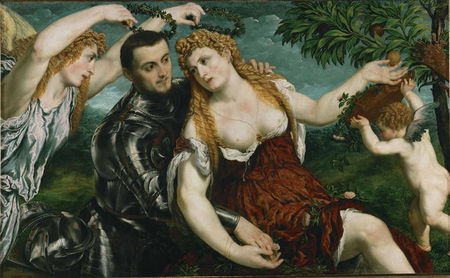

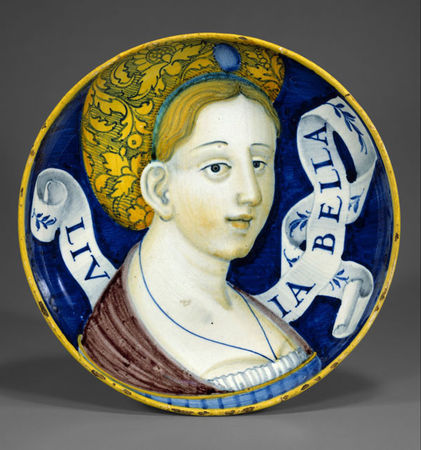


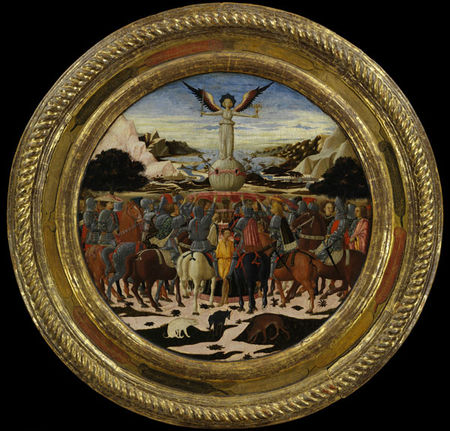

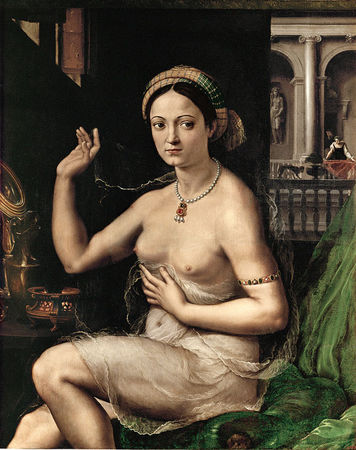


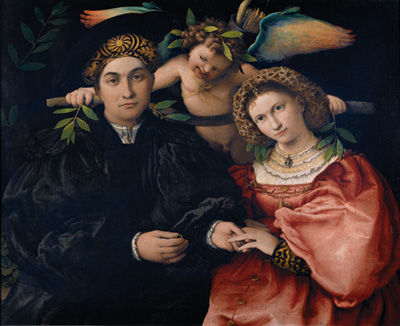

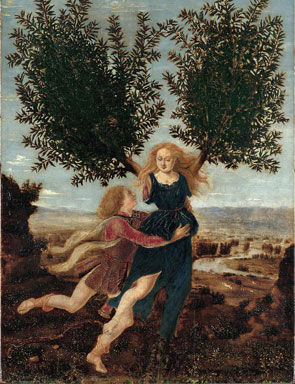
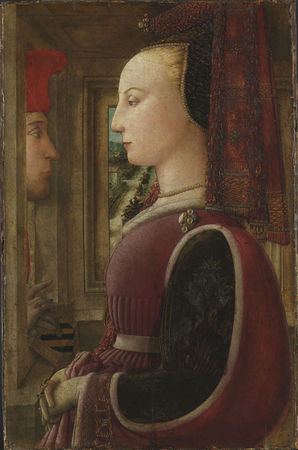
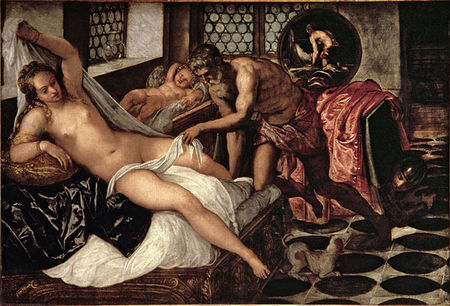
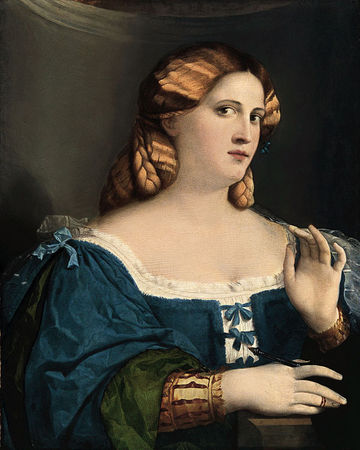


/http%3A%2F%2Fstorage.canalblog.com%2F86%2F42%2F119589%2F65871475_p.jpg)
/http%3A%2F%2Fstorage.canalblog.com%2F87%2F19%2F577050%2F48902980_o.jpg)
/http%3A%2F%2Fstorage.canalblog.com%2F54%2F32%2F577050%2F57328934_o.jpg)
/http%3A%2F%2Fstorage.canalblog.com%2F90%2F79%2F119589%2F47643086_p.jpg)